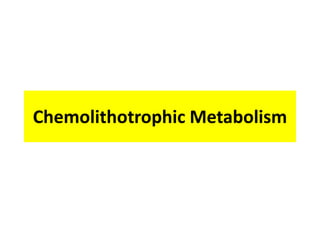
Chemolithotrophy: CO2 fixation, calvin cycle and key enzymes
- 2. Introduction • Some prokaryotes grow by using reduced inorganic compounds as their energy source and CO2 as the carbon source. These are called chemolithotrophs. • The electron donors used by chemolithotrophs include nitrogen and sulfur compounds, Fe(II), H2, and CO. • The Calvin cycle is the most common CO2 fixation mechanism, and the reductive TCA cycle, acetyl-CoA pathway and 3-ydroxypropionate cycle are found in some Chemolithotrophic prokaryotes. • Some can use organic compounds as their carbon source while metabolizing an inorganic electron donor. • This kind of bacterial metabolism is referred to as mixotrophy.
- 3. CO2 fixation pathways in chemolithotrophs Calvin Cycle Most Aerobic chemolithotrophs and photolithotrophs (95%) Reductive TCA cycle Some Aerobic chemolithotrophs and photolithotrophs (04%) acetyl-CoA pathway The anaerobic chemolithotrophs 3-hydroxypropionate cycle Rare Aerobic chemolithotrophs and photolithotrophs (01%)
- 4. • The Calvin cycle is the most common CO2 fixation pathway in aerobic chemolithotrophs and in photolithotrophs, and some fix CO2 through the reductive TCA cycle. • The anaerobic chemolithotrophs, including methanogens, homoacetogens and sulfidogens, employ the acetyl-CoA pathway to fix CO2. • A fourth CO2 fixation pathway, the 3- hydroxypropionate cycle, is known in some chemo- and photolithotrophs. • The Calvin cycle is the only known CO2-fixing metabolism in eukaryotes.
- 5. CALVIN CYCLE • The Calvin cycle, elucidated by American biochemist Melvin Calvin, is the most widely distributed pathway, operating in plants, algae, photosynthetic bacteria, and most aerobic lithoautotrophic bacteria.
- 6. • CO2 is condensed to ribulose-1,5- bisphosphate to produce two molecules of 3- phosphoglycerate.
- 7. • The molecules of 3-phosphoglycerate, then reduced to glyceraldehyde-3-phosphate.
- 8. • A molecule of glyceraldehyde-3-phosphate is isomerized to dihydroxyacetone phosphate. • Dihydroxyacetone phosphate then condensed with second glyceraldehyde-3- phosphate molecule through the reverse reactions of the EMP pathway to fructose- 1,6- diphosphate. • Fructose-1,6- diphosphate is dephosphorylated to fructose-6-phosphate by the action of fructose-1,6-diphosphatase
- 10. • Through carbon rearrangement two molecules of fructose-6-phosphate (2 x C6) and six molecules of glyceraldehyde-3-phosphate (6 x C3) are converted to six molecules of ribulose- 5-phosphate (6 x C5). • Ribulose-5-phosphate then phosphorylated to ribulose-1,5-bisphosphate to begin the next round of reactions.
- 11. Overall Reaction • 6CO2+18ATP+12NADPH+12H++12H2O • C6H12O6{glucose} +12NADP++18ADP +18Pi
- 13. Key enzymes of Calvin cycle • Ribulose-1,5-bisphosphate carboxylase and phosphoribulokinase are key enzymes of the Calvin cycle, and are present only in the organisms fixing CO2 through this highly energy-demanding pathway. • Their activities are controlled at the transcriptional level and also after they are expressed. • The enzymes are encoded by cbb genes organized in cbb operons
- 14. • CbbR is a transcriptional regulator and the key activator protein of cbb operons. • The cbbR gene is located adjacent to its cognate operon. • Phosphoenolpyruvate is a negative effector of CbbR, whereas NADPH is a coactivator of the protein.
- 15. • Ribulose-1,5-bisphosphate carboxylase is the most abundant single protein on Earth and is synthesized by all organisms fixing CO2 through the Calvin cycle including plants. • Two forms: Type I- Most common, consist of 8 large and 8 small subunits – form hexadecameric structure- widely distributed in CO2 fixing organisms. • Type-II – consist only large subunits (2, 4 or 8)- found in anaerobic organism.
- 16. Reductive TCA cycle • The bacterium does not have enzymes of the Calvin cycle, and fixes CO2 through the reductive TCA cycle. • This CO2-fixing metabolism shares TCA cycle enzymes that catalyze the reverse reactions. • Irreverse reactions are replaced by another set of enzymes.
- 18. • Some bacteria and archaea reduce CO2 to acetyl-CoA in the reverse direction of the TCA cycle. • The TCA cycle enzymes unable to catalyze the reverse reaction, i.e. citrate synthase, 2- ketoglutarate dehydrogenase and succinate dehydrogenase, are replaced by ATP:citrate lyase (8), 2-ketoglutarate synthase (5) and fumarate reductase (3).
- 19. • Acetyl-CoA is reduced to pyruvate by pyruvate:ferredoxin oxidoreductase. • Pyruvate converted to PEP by the action of PEP synthetase.
- 20. Co2 fixation through the acetyl CoA pathway • This pathway is employed for co2 fixation by anaerobic chemolithotrophs, including sulfidogens, methanogens and homoacetogens.
- 22. • 1. CO2 is reduced to formate by – formate dehydrogenase • 2. Formate is bound to tetrahydrofolate (H4F) and form formyl with help of enzyme formyl- H4F synthatase followed by reduced to methenyl---methylele---methyl formate. • This methyl group is transferred to coenzyme B12 (corrinoid). • Simillarly- second CO2 is reduced to CO (carbon monoxide) by – carbon monoxide dehydrogenase (CODH).
- 23. • This CO is enzyme bound and with help of CO- dehyderogenase, it form acetyl-CoA with involving methyl group from coenzyme B12. • CODH is duel function enzyme catalyzing CO oxidation and reduction and acetyl CoA synthesis/cleavage.
